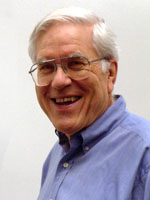
K. Larry DeVries
University of Utah
Professional Meets Personal
The Gordon Research Conferences have affected my professional life in a very personal way. In 1963, near the end of my first year on the faculty at the University of Utah, I was involved in preparing my first research proposal on the effects of high pressure on the properties of materials. Professor Baker, chair of the mechanical engineering department, on receiving an announcement of the upcoming Gordon Conferences, asked if I would like to attend the Research at High Pressures Conference that summer.
Attending the conference, held at Kimball Union Academy in Meriden, New Hampshire, remains one of the highlights of my career. Also in attendance were Harry G. Drickamer, George B. Benedek, and other researchers whose works I had came across in my literature search. I was starstruck and used what I learned at the conference to revamp my proposal before submitting it to the National Science Foundation (NSF). The resulting award was the first of nearly forty years of uninterrupted research support from NSF; the research it spawned was fun, interesting, and rewarding. Three years after receiving the first grant, colleague Wayne S. Brown and I successfully submitted a proposal to the Department of Defense to explore the properties of rocks under high pressures using equipment I had developed. Not suitable for a university environment, this applied research was put to use by a company called Terratek founded in 1969 for geotechnical testing for the gas and oil industries.
In 1969 I was looking for new research directions, and I had ideas (based on pioneering work by M. L. Williams) on how fracture mechanics and polymer science might be used in the analysis and design of adhesive joints. I applied to attend the Science of Adhesion GRC. Dominant leaders in adhesion and adhesive science, such as Robert L. Patrick, Louis H. Sharpe, Carl A. Dahlquist, and Alan N.Gent, were participants. Once more a Gordon Conference propelled my research group into an exciting area. I attended most of the next ten or so Science of Adhesion conferences. I was honored to be elected chair for the 1975 conference, where a group got together and, under the leadership of Gent, Patrick, and Sharpe, I helped organize the Adhesion Society. Today this society’s meetings draw participants from all over the world and is the world’s foremost organization promoting research and development in the area of adhesion and adhesives.
My graduate students and I have also been active in research relating to the fundamental mechanisms of deformation and failure of materials. While the origin of these research ideas cannot be traced to a specific Gordon Conference, we have attended Gordon Conferences that helped us refine our ideas for papers and proposals. In 1975 I was approached by Sidney J. Green and William Barry about contributing to their proposal for a new GRC called Deformation Mechanisms and Fracture of Polymers and Composites. I was later honored to be elected chair of its 1979 meeting. Many of our research group’s ideas on failure in materials either came from or were refined by the papers and discussions heard at these conferences. This conference still meets under the shortened name of Composites.
My attendance at and participation in several dozen Gordon Conferences has been impelled not only by the research incentives outlined above; I have also filled such roles as conference monitor for the Selection and Scheduling (S&S) Committee, board member, and board chair. Gordon Conferences have made me not only a better researcher but also a more interesting and motivating teacher. Participation in these conferences has helped me glean interesting examples of scientific and technical principles, as well as better and more interesting ways of expressing my thoughts.
GRC has also had a profound effect on me through my interactions with the people involved in the organization. One could not help but be impressed by the dedication and managerial acumen of the S&S Committee members, trustees, and GRC staff. I learned much from all of them, particularly the conference directors. During most of my involvement with GRC, Alex Cruickshank was the director, and under his tutelage the conferences grew in number and in national and international prominence. Alex was an effective, firm, and demanding manager, as well as a compassionate and great human being. During my last few years as a board member GRC was directed by Carlyle Storm, who increased office efficiency, brought management into the computer age, increased the number of conferences, and improved and expanded the number of conference sites. I have observed Nancy Gray, GRC’s new-est director, mostly from afar, but clearly she is, and will continue to be, a great director. She has furthered the growth of the conferences and is exploring ways to en-hance overseas operations. I consider all three directors to be not only excellent role models for good management but also valued personal friends.